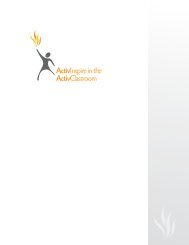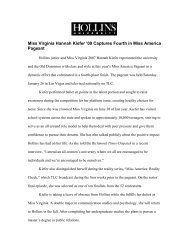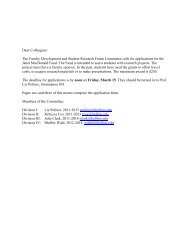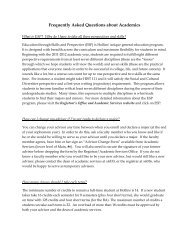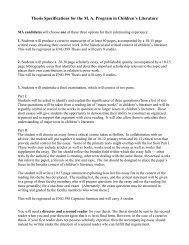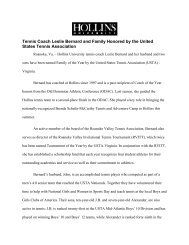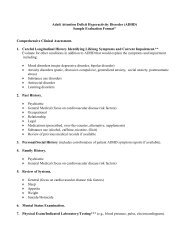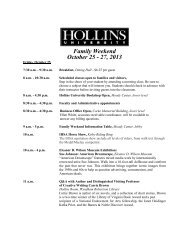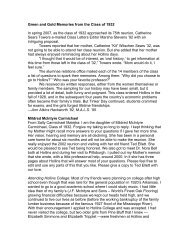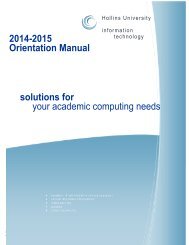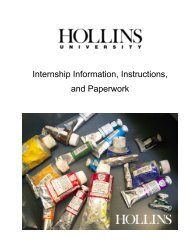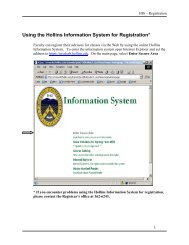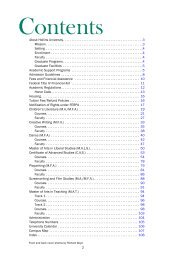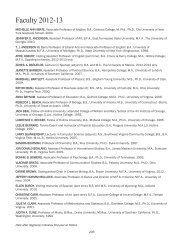ENGLISH & CREATIVE WRITING COURSE DESCRIPTIONS
ENGLISH & CREATIVE WRITING COURSE DESCRIPTIONS
ENGLISH & CREATIVE WRITING COURSE DESCRIPTIONS
Create successful ePaper yourself
Turn your PDF publications into a flip-book with our unique Google optimized e-Paper software.
ENG 160: EXTREME FICTIONS (4)<br />
American culture loves to take life to the extreme. From “extreme sports” and “extreme foods” to “extreme<br />
surgery” and even “extreme dating,” we are a culture that consistently rejects the center and gravitates toward<br />
the poles. In this interdisciplinary and writing‐intensive course, we examine works of prose, poetry, film, music,<br />
and television that are “extreme” in some way: extremely short or extremely long, extremely popular or<br />
extremely obscure, extremely political or extremely aesthetic, extremely serious or extremely nonsensical. In<br />
addition to discussing the impact that such various forms of excess have on narrative content and artistic merit,<br />
we consider why the trope of the extreme has remained so powerful and pervasive in the nation’s literature and<br />
culture.<br />
ENG 165: EXPLORING THE HARLEM RENAISSANCE (4)<br />
The Harlem Renaissance was a major period in American intellectual and artistic life. African Americans began to<br />
create literature that expressed a new found sense of self‐determination and self‐awareness. The period<br />
represented a fertile out‐pouring of creative work that articulated a new vision for the 20th century. It brought<br />
together the voices of writers like Langston Hughes, Jean Toomer, and Zora Neale Hurston, along with painters<br />
like Aaron Douglass, sculptors like Sargent Johnson, and musicians like Duke Ellington and Louis Armstrong. The<br />
primary goal of this course is to introduce students to various rhetorical and stylistic methods that these writers<br />
and artists used to examine issues of nationalism, gender, racism, and economic disparity. No prerequisite.<br />
ENG 168: NOVELS WE ALL SHOULD HAVE READ (4)<br />
This course focuses on a selection of memorable novels by major writers of the 19th and 20th centuries.<br />
Emphasis will be placed on a conscientious reading of texts with the aim of enhancing aesthetic appreciation<br />
and understanding the moral issues that the novels convey. Attention will be paid to the development of a<br />
critical vocabulary and an understanding of the historical contexts in which the texts were written. No<br />
prerequisite.<br />
ENG 197F: FIRST‐YEAR SEMINAR – AMERICAN DREAMS/AMERICAN NIGHTMARES (4)<br />
“Oh brave new world!” or Nightmare on Elm Street? The discovery of America set in motion the development of<br />
a myth, an ideal that persists today, the American Dream. The phrase, first used by James Truslow Adams in his<br />
book The Epic of America in 1931, existed even before the discovery of the North American continent and has<br />
evolved and morphed over time. However, there proved to be an underside to the American Dream. The Great<br />
Depression, with its images of migrant and destitute workers, was one aspect. The Vietnam War proved to be<br />
another. This first‐year seminar explores the development of the American Dream and its opposite, the<br />
American Nightmare, through literature and film. We will begin by reading texts related to the discovery of<br />
American and European expectations for the “new world.” Then we will explore various modern literary works,<br />
including several important American novels: F. Scott Fitzgerald’s The Beautiful and the Damned, Richard<br />
Wright’s Native Son, Norman Mailer’s Armies of the Night, and Toni Morrison’s Beloved. Concurrently with the<br />
discussions of these novels, we will critically evaluate such films as John Ford’s The Grapes of Wrath, based on<br />
John Steinbeck’s novel, Orson Wells’ Citizen Kane, The Deer Hunter, directed by Michael Cimino and starring<br />
Robert De Niro, and Sam Mendes’ American Beauty. Placement to be determined during the summer.<br />
ENG 197F: FIRST‐YEAR SEMINAR ‐ <strong>CREATIVE</strong> CODE: THE ART AND SCIENCE OF INTERACTIVE MEDIA (4)<br />
The field of interactive media, examples of which include computer‐based art and hypertext poetry, is redefining<br />
both art and science. In this seminar, we will work at the intersection of several emerging fields: computer<br />
animation, interactivity, and hypertext literature. Placement to be determined during the summer.<br />
ENG 197F: FIRST‐YEAR SEMINAR – EDIBLE POETRY (4)<br />
Close reading and discussion of poems that deal with food, its gathering, preparation, sharing, and eating.<br />
Poems by Roethke, Hongo, Espada, Neruda, Rich, Gluck, Li‐Young Lee, Tracy K. Smith, Wendell Berry, Langston<br />
Hughes, Frank O’Hara, and those of many other authors will be explored. As we encounter these works in



